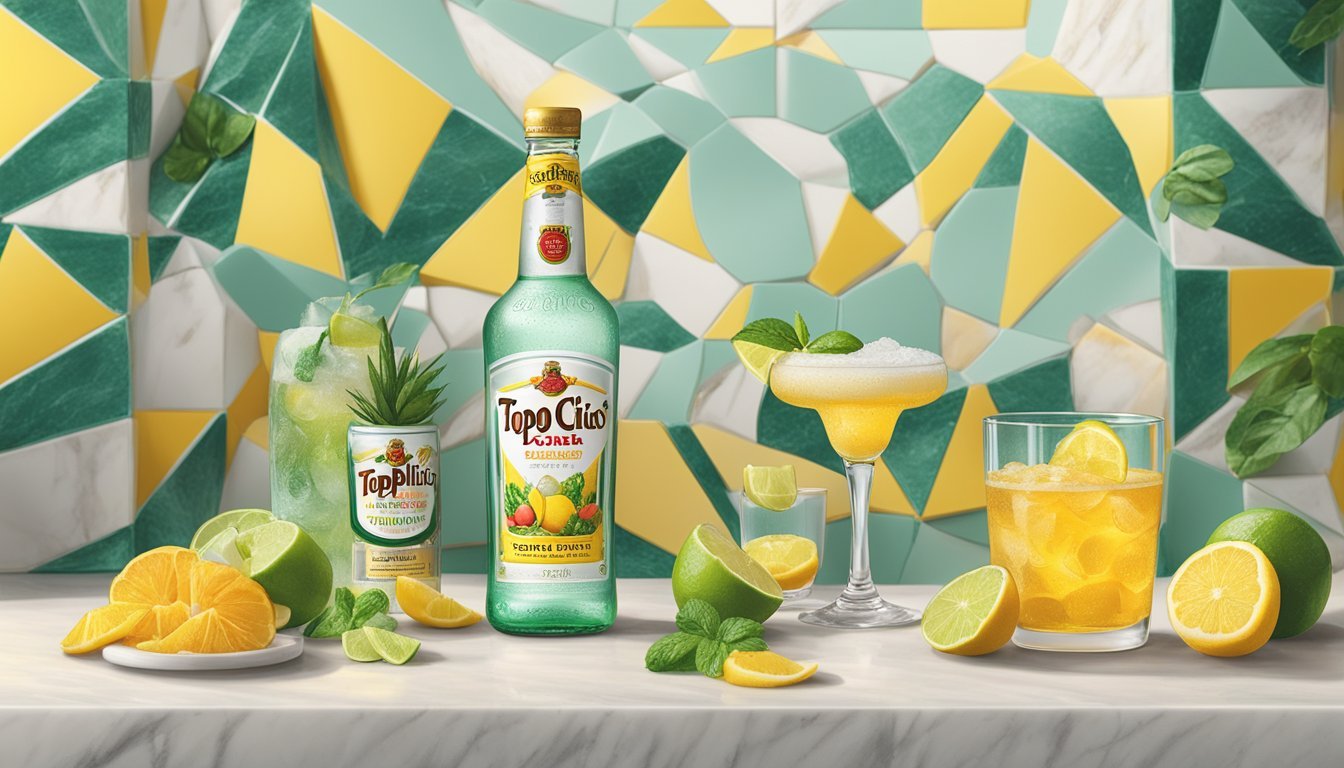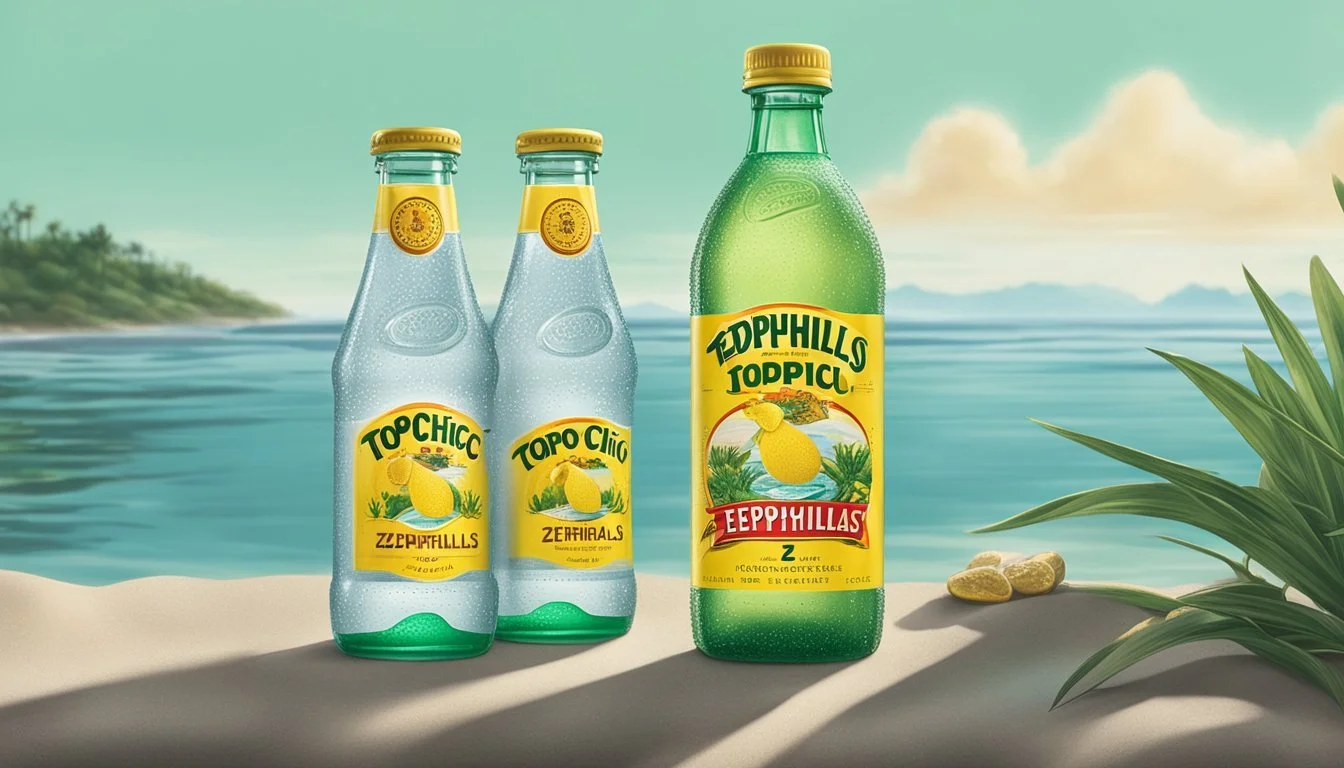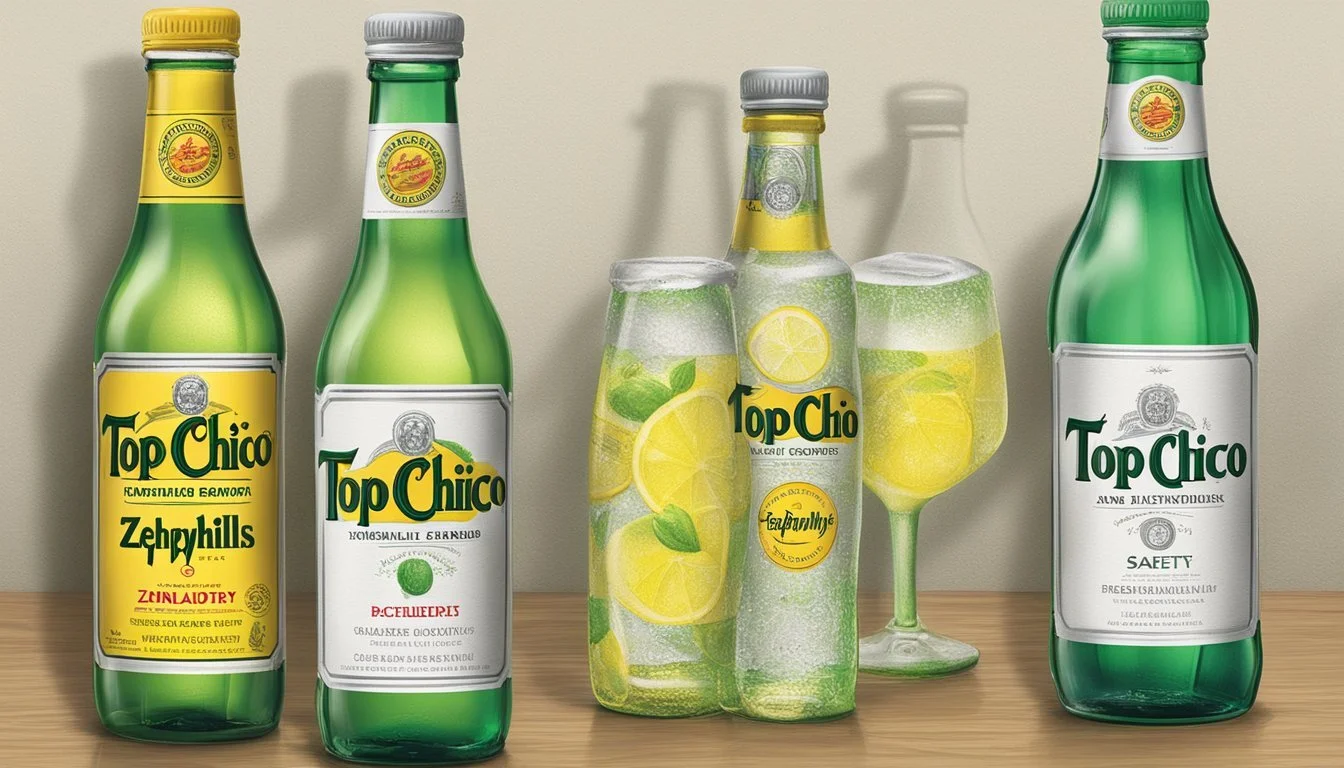Topo Chico vs. Zephyrhills
The Ultimate Bottled Water Showdown
Topo Chico and Zephyrhills represent two distinct styles of bottled water that have built a loyal customer base. Topo Chico, a sparkling mineral water sourced from Monterrey, Mexico, has a long history dating back to 1895. Its lively effervescence and mineral composition have made it a favorite among those who prefer a bubbly alternative to still water. Its presence in the United States has grown significantly, with many choosing it for its crisp taste that pairs well with various foods and beverages, or as a refreshing drink on its own.
In contrast, Zephyrhills is a brand of spring water that comes from various springs in Florida and has been a staple in the southeastern United States. The brand emphasizes its local sourcing and natural filtration process, which appeals to consumers looking for a taste of Florida's natural resources. While it lacks the carbonation of Topo Chico, Zephyrhills offers a taste that is often described as clean and pure, making it a go-to choice for those who prefer still water.
When comparing Topo Chico and Zephyrhills, consumers look beyond just taste preferences; they consider factors such as the source of the water, the mineral content, and the environmental impact of packaging and transportation. Both brands have their unique qualities that cater to different needs, making it important for individuals to understand the characteristics that define Topo Chico and Zephyrhills to determine which bottled water is better for their personal preference and lifestyle.
Origins and History
The historical roots of Topo Chico and Zephyrhills mineral waters are as rich and distinct as their flavors. Each brand has its unique inception story, burgeoning from natural sources steeped in local heritage.
Topo Chico's Roots in Monterrey
Topo Chico traces its origins back to the northern Mexican city of Monterrey, situated near the Cerro del Topo Chico. The water is sourced from the limestone-rich springs that are heated by the geothermal energy of this inactive volcano, giving the water its signature mineral composition and effervescence. Historical records suggest that Topo Chico was formally bottled and commercialized starting in 1895, making it a long-standing staple in the world of mineral water.
Zephyrhills: From Florida Springs to Bottles
In contrast, Zephyrhills emerges from the natural springs in Florida. The town of Zephyrhills, named after the Greek word for the 'west wind,' became renowned for its pure water sources. The commercial bottling of this water began much later than Topo Chico, with companies recognizing the potential of the clear, refreshing water that was a product of Florida's unique aquifer systems. The water from Zephyrhills has been quenching thirsts for decades, cementing its place in the American bottled water market.
Mineral Content and Health Benefits
This section explores the mineral content of Topo Chico and Zephyrhills bottled waters, evaluating their potential health benefits and discussing their unique mineral compositions and purification processes.
Evaluating Mineral Water Benefits
Mineral water is appreciated for its content of various minerals such as magnesium, calcium, potassium, and sodium, which are essential for many bodily functions. The presence of these minerals contributes to health benefits, including improved digestion and hydration. It is often recommended by health professionals like Dr. Peter Attia to look for water with a higher concentration of total dissolved solids (TDS) for greater mineral intake.
Topo Chico's Mineral Composition
Topo Chico's mineral water boasts a noteworthy level of minerals. It satisfies the FDA's requirement of at least 250 parts per million total dissolved solids, contributing to its characteristic flavor and potential as a healthier alternative to soft drinks. Topo Chico's rich mineral content includes:
Magnesium: Beneficial for enzyme function and energy production
Calcium: Essential for bone health and muscle function
Potassium: Crucial for heart function and muscle contractions
Sodium: Important for fluid balance and nervous system operation
Zephyrhills: Purification and Minerals
Zephyrhills water undergoes a comprehensive purification process, which includes micro-filtration, ozone disinfection, reverse osmosis, and UV treatment to meticulously remove contaminants. The purification process ensures safety and cleanliness, while still retaining valuable minerals:
Calcium & Magnesium: Found in levels that contribute to taste and potential health advantages
Potassium & Sodium: Present in balance, maintaining hydration and assisting in muscle and nerve function
The mineral composition in Zephyrhills and its purification processes guarantee the water's purity and its contribution to overall mineral intake.
Taste and Carbonation Experience
The section explores the distinct taste profiles and carbonation levels of Topo Chico and Zephyrhills bottled waters, focusing on how these attributes contribute to the overall drinking experience.
The Unique Appeal of Topo Chico
Topo Chico Mineral Water is renowned for its high carbonation levels, which provide a robust effervescence that many find particularly refreshing. The carbonation in Topo Chico is often described as sharp, able to impart a lively "slicing bubble" sensation. This characteristic, coupled with a hint of minerals, offers a distinct, crisp taste that may be less earthy than other mineral waters due to its lower mineral content. Topo Chico also presents a variety of flavors such as Twist of Lime and Twist of Grapefruit, which infuse the sparklings water with a subtle yet noticeable citrus accent, enhancing its appeal.
The Freshness of Zephyrhills
Zephyrhills is a brand known for sourcing its water from Florida's springs, providing a taste that is fresh with a natural purity. The carbonation level in Zephyrhills sparkling water is moderate, creating a balanced effervescence that complements rather than overpowers the water's flavor profile. Those who prefer a softer, more subtle carbonation experience might lean towards Zephyrhills. While it may not boast the intense fizz of some competitors, it offers a smooth and refreshing experience that is particularly thirst-quenching. Zephyrhills also provides flavored options, like lemon and lime, which add a light, citrusy taste without overwhelming the natural flavor of the spring water.
Packaging and Environmental Impact
The environmental footprint of bottled water is often defined by the materials used for packaging and the associated recycling or sustainability programs. Consumer choices between brands like Topo Chico and Zephyrhills might be influenced by these factors.
Bottle Materials: Glass vs. Plastic
Topo Chico traditionally bottles its water in glass bottles, which are 100% recyclable and can be reused indefinitely without loss of quality. However, glass is heavier and more energy-intensive to transport, potentially increasing its carbon footprint.
Zephyrhills, on the other hand, primarily uses plastic bottles. Plastic is lighter than glass, reducing transportation emissions. It's also recyclable, but not all plastic bottles are recycled, and they can degrade in quality each time they are processed.
Sustainability Efforts and Criticisms
Topo Chico has faced scrutiny regarding its recycling policies and the environmental impact of its bottling. Nonetheless, it is recognized that these glass bottles may enter the green recycling stream, assuming local facilities can process them.
Zephyrhills has sustainability initiatives in place to reduce its footprint. The brand uses bottles made from recycled plastic and has outlined commitments to make its packaging more sustainable. However, producing plastic bottles is still associated with significant CO2 emissions. Despite efforts to lessen impact, the sustainability of the bottled water industry continues to be a point of criticism from environmentalists.
Market Presence and Consumer Choice
In the realm of bottled water, sales and consumer reports play pivotal roles in shaping market presence and guiding consumer choice. Both Topo Chico and Zephyrhills have carved out unique spaces in the beverage market, each appealing to different consumer bases with their distinct offerings.
Sales Figures and Market Share
Topo Chico, a brand owned by Coca-Cola, holds a significant position in the sparkling water segment. Its sales have been bolstered by a cult following and its popularity in states like Texas. Recently, a shift towards healthier lifestyles has benefited the brand, as consumers frequently turn to sparkling water as an alternative to sugary sodas. Although specific sales figures were not provided in the search results, mentions by reputable sources such as Consumer Reports and The New York Times, imply a strong market presence.
Zephyrhills, while not specifically mentioned in the search results, is known to have a strong presence in the southeastern United States, particularly in Florida, which serves as its primary market. The brand, which is a part of the Nestlé family, benefits from the parent company's extensive distribution network, positioning it favorably in terms of market share in its regional market.
Brand Loyalty and Consumer Reports
When it comes to brand loyalty, both brands have their dedicated consumer bases, with Topo Chico enjoying a reputation for its mineral-rich flavor profile and Zephyrhills for its crisp taste from Florida’s springs. Consumer Reports has highlighted the reduction of PFAS levels in Topo Chico, suggesting an responsiveness to health concerns, which could influence consumer choice positively.
In terms of consumer perception, online retail platforms such as Amazon offer insight through customer reviews and ratings. These platforms serve as a modern-day barometer for consumer sentiment, showing how factors like taste, price, and brand trust come into play.
By considering both sales figures and consumer feedback, it becomes evident that both Topo Chico and Zephyrhills maintain their market presence through a combination of strong brand identities and a keen ear to consumer preferences and health trends.
Use in Beverages and Cocktail Culture
As the popularity of bottled waters like Topo Chico and Zephyrhills continues to rise, their distinct qualities have infused new life into beverage and cocktail culture. Each brand brings a unique touch to refreshments, influencing the choice of mixologists and consumers alike.
Topo Chico: The Bartender's Choice
Topo Chico, with its crisp carbonation and minerality, is preferred by bartenders and cocktail enthusiasts for a variety of mixed drinks. Its effervescence is particularly favored in highball cocktails and Palomas, where the soda's bite complements spirits like tequila sharply and cohesively.
Cocktail Applications:
Ranch Water: Mix Topo Chico with tequila and fresh lime juice for this Texas-born, minimalistic cocktail.
Tequila-based drinks: The bubbliness of Topo Chico adds a sparkling lift, especially to fruity concoctions.
Hard Seltzer: As an ingredient in Topo Chico Hard Seltzer, it seamlessly bridges the gap between sparkling mineral water and alcohol, providing a lighter alcoholic beverage option.
Zephyrhills in Non-Alcoholic Refreshments
In contrast, Zephyrhills is often chosen for its pure taste in non-alcoholic beverages, providing clean hydration without altering the flavor profile of drinks. Its pleasing neutrality makes it an excellent base for fruity, non-alcoholic refreshments where the natural flavors of ingredients are intended to shine through.
Non-Alcoholic Drink Uses:
Fruit Infusions: Subtle notes of fruit are underscored by the gentle qualities of Zephyrhills water.
Alternative to Sparkling Water: For those who prefer less carbonation, Zephyrhills is a reliable choice in non-alcoholic highballs and mocktails, offering a smooth sip without the effervescence of options like LaCroix or Topo Chico.
Comparison of Filtration and Purity
The filtration and purity of a bottled water brand are essential in determining its quality and safety for consumption. This section explores the specific processes used by Topo Chico and Zephyrhills to maintain the purity and quality of their water.
The Filtration Process of Topo Chico
Topo Chico's filtration process includes multiple steps designed to ensure the water's safety and purity. Initially sourced from the Cerro del Topo Chico spring in Mexico, the water undergoes a thorough filtration method that includes ozonation and carbon filtering. The company ensures that these steps eliminate any potential contaminants and pfas chemicals, commonly found in trace amounts in tap and bottled waters. Topo Chico prides itself on a stringent purification process that complies with both local and international standards.
Zephyrhills: Natural Purity and Contaminants
Zephyrhills sources its water from Florida's natural springs, boasting that it undergoes minimal processing due to the water's natural purity. The water is filtered naturally through layers of rock which provides a natural filtration system, and then it's disinfected to ensure it's free from bacteria. Despite its natural source, Zephyrhills regularly tests for contaminants and pfas chemicals, which are a concern for consumers looking for purely natural water. The brand focuses on maintaining a balance between preserving the natural qualities of the spring water and ensuring its safety through rigorous quality control measures.
Legislation and Safety Standards
In evaluating the safety and quality of bottled water, it's essential to consider the role that federal regulations and public concerns play in shaping industry practices.
FDA Regulations and Bottled Water Safety
The Food and Drug Administration (FDA) governs bottled water safety standards in the United States, setting limits on levels of various contaminants. These regulations are designed to ensure that bottled water products sold in the U.S., including brands like Zephyrhills, Dasani, Aquafina, and Smartwater, provide a safe level of consumption for the public. EPA standards for public water systems act as a benchmark, but the FDA has additional rules for water that crosses state lines. The FDA's standards apply to various types of bottled water, such as mineral, spring, artesian, and purified water.
Tolerance Levels: They establish Maximum Contaminant Levels (MCLs) for microbial, chemical, and radiological contaminants that might pose a health risk.
Inspections and Compliance: Bottled water facilities are subject to FDA inspection and must adhere to Good Manufacturing Practices (GMPs).
Labeling Requirements: The FDA also mandates clear labeling to inform consumers about the source and type of water inside the bottle.
Public Concerns and Legal Actions
Public scrutiny of the bottled water industry has intensified due to reports of contamination with chemicals such as PFAS—a group of man-made compounds with associated health risks. Studies have shown varying levels of PFAs in brands like Topo Chico, Poland Spring, and Arrowhead, leading to increased calls for more stringent safety tabs;les and federal leadership.
Class-Action Lawsuits: Consumers have responded with legal action, filing class-action suits against companies alleging contamination and false advertising.
Response from Brands: Companies like Nestlé and Coca-Cola, which owns brands like Topo Chico and Smartwater, are compelled to test and reduce levels of contaminants like PFAS in their bottled waters to maintain consumer trust and regulatory compliance.
Concerns over water purity have influenced the practices of bottled water companies, driving a trend towards increased transparency and safety measures to protect public health and satisfy consumer expectations.
The Future of Bottled Water
The conversation surrounding bottled water is shifting, with the focus on sustainable practices and consumer health driving the industry forward. Innovations and changing consumer trends guide the trajectory of companies like Coca-Cola and bottled brands such as Essentia, Fiji, and Zephyrhills.
Innovations in the Water Industry
The water industry is actively integrating new technologies to address quality and sustainability concerns. Coca-Cola, for instance, responded to health critiques by reducing PFAS levels in Topo Chico, showcasing a broader trend of companies prioritizing product purity. Additionally, the market is witnessing a rise in filtration and purification techniques, ensuring that brands like Essentia and Fiji continue to meet health standards while maintaining flavor.
Efforts to lower the environmental impact are underway, with water brands developing biodegradable bottles and renewable resource-based packaging. Water reuse systems and desalination projects are also being pursued to meet the increasing demand for freshwater without exacerbating water scarcity.
Consumer Trends and Predictions
Consumer preferences are increasingly leaning towards health and environmental sustainability. Brands that demonstrate a commitment to these areas are likely to see growth. As such, indicators suggest consumer loyalty strengthening for brands like Essentia, which boasts a high pH alkaline water, viewed as beneficial to health by some consumers.
The market has also observed a rise in demand for flavored sparkling waters, with brands like Topo Chico expanding their product lines to cater to this trend. Added to this is the growth in e-commerce, which allows for direct-to-consumer sales models, providing opportunities for water brands to strengthen their distribution channels. These factors collectively suggest a future where diversification of products and online engagement with consumers will be pivotal for a brand's success.








